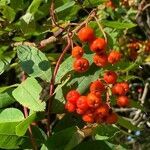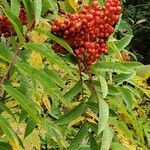Shrubs or trees, 40–100 dm. Stems 1–4+; bark gray to bronze; winter buds green to purple, shiny, ovoid to conic, 7–20 mm, glutinous, glabrous or hairy along scale margins and at apex, hairs primarily rufous. Leaves pinnately compound; stipules early deciduous, rufous-ciliate, ?margins sometimes glandular?; blade paler abaxially, dull green to yellowish green adaxially, leaflets 11–17, opposite, lanceolate to oblong-lanceolate, 5–10 × 1–2.5 cm, l/w ratio 3.4–5, margins serrulate to serrate, at least in apical 1/2 and often almost to base, apex acuminate to long acuminate, surfaces glabrous or glabrate at flowering, some hairs occasionally persisting abaxially along midvein; leaflet axils and petiole bases glabrous or with rufous and/or whitish hairs adaxially. Panicles 125–400+-flowered, flat-topped or rounded, 6–15 cm diam.; peduncles glabrous or sparsely villous. Pedicels glabrous or sparsely villous. Flowers 5–7.5(–8.5) mm diam.; hypanthium glabrous, hypanthium plus sepals 2–2.5 mm; sepals 0.5–1 mm, margins entire, often with a few thick glands; petals white, orbiculate to obovate, (2–)2.5–3.5(–4) mm; stamens 14–20; carpels 1/2 adnate to hypanthium, apex conic, styles 3 or 4, 1.5–2 mm. Infructescences glabrous or sparsely villous. Pomes bright red to orange-red, globose to subglobose, 4–7 mm diam., shiny, not glaucous; sepals inconspicuous, incurved. Seeds brown, yellowish when fresh or immature, ovoid to ovoid-lanceoloid, 2.5–3.3 × 1.5–2 mm, asymmetric, slightly flattened. 2n = 34.
More
A deciduous shrub or small tree. It grows up to 8-10 m high. It has a short trunk. The bark is grey and smooth. The leaves are alternate and compound. The leaflets are curved and sword shaped. They taper to the tip. They are 5-8 cm long. They are thin and light green above and paler underneath. They are more narrow than showy mountain ash. (S. decora). The flowers have petals which are broadest toward the tip. They are 3-4 mm long. They are in dense flat clusters. The fruit are bright coral-red. They are 4-6 mm across. They have thin flesh.
Shrub or tree to 10(–15) m; twigs glabrous or nearly so; winter-buds glutinous, with glabrous or sparsely ciliate scales; lfls lanceolate to narrowly oblong, gradually acuminate, 5–9 cm, mostly 3–5 times as long as wide, sharply serrate, paler and usually glabrous beneath; infl 6–15 cm wide; hypanthium and sep glabrous; pet obovate, 3–4 mm, narrowed to the base, equaling or longer than the stamens; fr 4–7 mm thick; 2n=34. In moist or wet soil; Nf. to Minn., s. to Pa. and n. Ill., and in the mts. to n. Ga. May, June. (Pyrus a.)
Can be grown by cuttings, graftings or seedlings. Seeds needs stratification.








